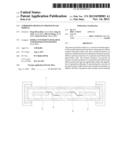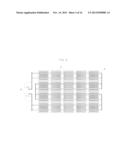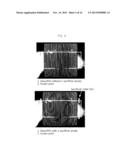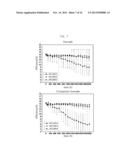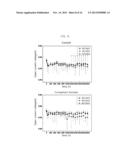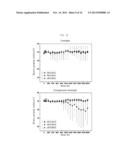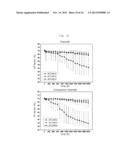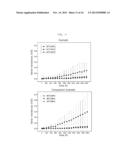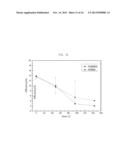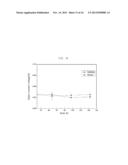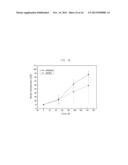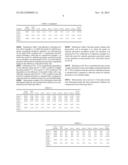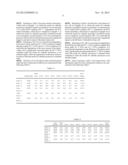Patent application title: CORROSION-RESISTANT PHOTOVOLTAIC MODULE
Inventors:
Dong-Hwan Kim (Seoul, KR)
Dong-Hwan Kim (Seoul, KR)
Sung-Ju Tark (Seoul, KR)
Min-Gu Kang (Seoul, KR)
Sung Eun Park (Busan, KR)
Assignees:
KOREA UNIVERSITY RESEARCH AND BUSINESS FOUNDATION
IPC8 Class: AH01L310224FI
USPC Class:
136256
Class name: Photoelectric cells contact, coating, or surface geometry
Publication date: 2013-11-14
Patent application number: 20130298983
Abstract:
The present invention relates to a corrosion-resistant photovoltaic
module characterized in that an interconnector ribbon connects the
photovoltaic cells and a sacrificial metal as an anode for cathodic
protection is attached to the interconnector ribbon to prevent corrosion
of a connective part between the photovoltaic cells. The present
invention can prevent an increase of serial resistance at a connective
part between the ribbon and the cell and can significantly reduce the
degradation of generation efficiency by preventing the corrosion of the
interconnector ribbon due to the external environment. In addition, the
life of the photovoltaic module can be extendedClaims:
1. A corrosion-resistant photovoltaic module comprising at least one
anode for cathodic protection attached to the interconnector ribbon in
the photovoltaic module comprising at least one photovoltaic cells and
interconnector ribbon.
2. The corrosion-resistant photovoltaic module of claim 1, wherein the interconnector ribbon is at least one selected from the group consisting of a Cuelectrode coated with Sn--Pballoy, a Cuelectrode coated with Sn, a Cuelectrode coated with Sn--Pb--Agalloy, a Cuelectrode coated with Sn--Agalloy, and a Cuelectrode coated with Sn--Ag--Cu alloy.
3. The corrosion-resistant photovoltaic module of claim 1, wherein the anode for cathodic protection is a metal having ionization tendency which is higher than the interconnector ribbon metal.
4. The corrosion-resistant photovoltaic module of claim 3, wherein the anode for cathodic protection is at least one selected from the group consisting of Mg, Mgalloy, Al, Alalloy, Zn, and Znalloy.
5. The corrosion-resistant photovoltaic module of claim 1, wherein size of the anode for cathodic protection is larger than that of the cathode.
6. The corrosion-resistant photovoltaic module of claim 1, wherein the anode for cathodic protection is positioned at a conductor having relatively higher current in the photovoltaic cells.
7. The corrosion-resistant photovoltaic module of claim 6, wherein the conductor having relatively higher current is bus ribbon or bus bar.
Description:
TECHNICAL FIELD
[0001] The present invention relates to a corrosion-resistant photovoltaic module, and more particularly to a corrosion-resistant photovoltaic module including an anode for cathodic protection attached to an interconnector ribbon.
BACKGROUND ART
[0002] Photovoltaic cell is a semiconductor device that converts light energy into electric energy using the photoelectric effect. The photovoltaic cell utilizing solar energy has more attention recently as viable alternative energy sources and global market scale thereof is rapidly increased due to its low cost.
[0003] Actual required voltage is in the tens or even hundreds of V or higher, but voltage generated from one-cell is 0.5V which is very small value. Thus, a plurality of photovoltaic cells are used by being connected in a serial or parallel. A part connecting between such cells is called as an interconnector ribbon and structure in which such cells are connected to have electromotive force is called as a photovoltaic module.
[0004] However, when the photovoltaic module is exposed to an external environment for a long period of time, the interconnector ribbon gets oxidized and corroded due to various reasons such as moisture and the like and eventually causes a significant increase of resistance which results in deteriorating the efficiency of the photovoltaic cell.
[0005] A connective part between the interconnector ribbon and the photovoltaic cell becomes oxidized due to external temperature, humidity and the like. It may cause corrosion of the interconnector ribbon, increase of degradation, and reduction of voltage and current due to increase of serial resistance of the photovoltaic cell.
[0006] KR 1994-7002010 discloses a protective coating of an inorganic material having corrosion resistance in order to prevent the corrosion of the photovoltaic cell.
[0007] KR 2010-0134882 discloses two protective layers having two different properties to improve moisture resistance and eventually to prevent the corrosion of the photovoltaic cell.
[0008] However, such technologies have drawbacks in increase of manufacturing cost and manufacturing time since additional processes and materials are required.
SUMMARY OF THE INVENTION
[0009] The inventors have completed the present invention with an effort to develop a photovoltaic module which can solve the above-mentioned problems associated with the conventional technologies.
[0010] It is an object of the present invention to provide a corrosion-resistant photovoltaic module comprising an interconnector ribbon connecting photovoltaic cells and an anode for cathodic protection attached to the interconnector ribbon to prevent corrosion of a connective part between the photovoltaic cells.
[0011] In order to achieve the above-mentioned object, there is provided a corrosion-resistant photovoltaic module including at least one anode for cathodic protection attached to the interconnector ribbon in the photovoltaic module comprising at least one photovoltaic cells and interconnector ribbon.
[0012] In a corrosion-resistant photovoltaic module according to an embodiment of the present invention, the interconnector ribbon may be at least one chosen from a Cuelectrode coated with Sn--Pballoy, a Cuelectrode coated with Sn, a Cuelectrode coated with Sn--Pb--Agalloy, a Cuelectrode coated with Sn--Agalloy, and a Cuelectrode coated with Sn--Ag--Cu alloy.
[0013] In a corrosion-resistant photovoltaic module according to an embodiment of the present invention, the anode for cathodic protection may be sacrificial anode.
[0014] In a corrosion-resistant photovoltaic module according to an embodiment of the present invention, the anode for cathodic protection may be a metal having ionization tendency which is higher than the interconnector ribbon metal.
[0015] In a corrosion-resistant photovoltaic module according to an embodiment of the present invention, the anode for cathodic protection may be at least one chosen from Mg, Mgalloy, Al, Alalloy, Zn, and Znalloy.
[0016] In a corrosion-resistant photovoltaic module according to an embodiment of the present invention, size of the anode for cathodic protection may be larger than that of the cathode.
[0017] In a corrosion-resistant photovoltaic module according to an embodiment of the present invention, the anode for cathodic protection may be positioned at a relatively high current conductor in the photovoltaic cells.
[0018] In a corrosion-resistant photovoltaic module according to an embodiment of the present invention, the anode for cathodic protection may be positioned at bus ribbon or bus bar.
[0019] According to another aspect of the present invention, there is provided a method for preventing corrosion of a photovoltaic module by preventing corrosion of the interconnector ribbon as a method for preventing corrosion of a photovoltaic module including at least two photovoltaic cells and an interconnector ribbon connecting between the photovoltaic cells.
[0020] According to the present invention, it can prevent an increase of serial resistance at a connective part between the ribbon and the cell and can significantly reduce the degradation of efficiency by preventing the corrosion of the interconnector ribbon caused due to the external environment. In addition, the life of the photovoltaic module can be extended
BRIEF DESCRIPTION OF DRAWINGS
[0021] FIG. 1 is a view illustrating the structure of a photovoltaic module.
[0022] FIG. 2 is a front view (a), a plan view (b) and a rear view of the photovoltaic cells connected with an interconnector ribbon.
[0023] FIG. 3 is a diagram of a photovoltaic module including photovoltaic cells connected with an interconnector ribbon.
[0024] FIG. 4 illustrates a position to which an anode for cathodic protection can be attached on the interconnector ribbon in the structure of FIG. 3.
[0025] FIG. 5 illustrates a photovoltaic cell prepared according to an embodiment of the present invention. The left view is the structure without an anode for cathodic protection and the light view is that with an anode for cathodic protection.
[0026] FIG. 6 illustrates gradual corrosion of an anode for cathodic protection over time.
[0027] FIG. 7 illustrates graphs comparing efficiencies of photovoltaic cells with and without an anode for cathodic protection (left: Example, right: Comparison Example).
[0028] FIG. 8 illustrates graphs comparing open current voltages (Voc) of photovoltaic cells with and without an anode for cathodic protection (left: Example, right: Comparison Example).
[0029] FIG. 9 illustrates graphs comparing short current (Jsc) of photovoltaic cells with and without an anode for cathodic protection (left: Example, right: Comparison Example).
[0030] FIG. 10 illustrates graphs comparing fill factors (FF) of photovoltaic cells with and without an anode for cathodic protection (left: Example, right: Comparison Example).
[0031] FIG. 11 illustrates graphs comparing serial resistances (Rs) of photovoltaic cells with and without an anode for cathodic protection (left: Example, right: Comparison Example).
[0032] FIG. 12 illustrates graphs of changes in efficiencies of photovoltaic cells with and without an anode for cathodic protection 144 hours later after salt spray (NGSA: Example, NGNSA: Comparison Example).
[0033] FIG. 13 illustrates graphs of open current voltage of photovoltaic cells with and without an anode for cathodic protection 144 hours later after salt spray (NGSA: Example, NGNSA: Comparison Example).
[0034] FIG. 14 illustrates graphs of short currents of photovoltaic cells with and without an anode for cathodic protection 144 hours later after salt spray (NGSA: Example, NGNSA: Comparison Example).
[0035] FIG. 15 illustrates graphs of fill factor of photovoltaic cells with and without an anode for cathodic protection 144 hours later after salt spray (NGSA: Example, NGNSA: Comparison Example).
[0036] FIG. 16 illustrates graphs of serial resistances of photovoltaic cells with and without an anode for cathodic protection 144 hours later after salt spray (NGSA: Example, NGNSA: Comparison Example).
DETAILED DESCRIPTION OF THE INVENTION
[0037] While the present invention has been described with reference to particular embodiments, it is to be appreciated that various changes and modifications may be made by those skilled in the art without departing from the spirit and scope of the present invention, as defined by the appended claims and their equivalents. Throughout the description of the present invention, when describing a certain technology is determined to evade the point of the present invention, the pertinent detailed description will be omitted.
[0038] According to the present invention, there is provided a corrosion-resistant photovoltaic module including at least one anode for cathodic protection attached to the interconnector ribbon in the photovoltaic module comprising at least two photovoltaic cells and interconnector ribbon connecting between the photovoltaic cells.
[0039] A photovoltaic system is configured with photovoltaic cell, photovoltaic module, photovoltaic panel, photovoltaic array, power conditioning system (PCS), and storage device, etc. The photovoltaic module receives the light and converts it into electricity. As shown in FIG. 1 illustrating the structure of a photovoltaic module, the photovoltaic module generally includes surface material (tempered glass) 1, filler (EVA) 2, photovoltaic cell 3, interconnector ribbon connecting between cells 4, and surface material (tedra) 5.
[0040] FIG. 2 illustrates a front view (a), a plan view (b) and a rear view of the structure of photovoltaic cells connected with an interconnector ribbon. The photovoltaic module includes a plurality of the photovoltaic cells 3 and interconnector ribbons 4 connecting the photovoltaic cells 3 at the top and the bottom.
[0041] The interconnector ribbon 4 connects between the photovoltaic cells 3 in the photovoltaic module. The interconnector ribbon 4 is usually a metallic material coated with Pb but it is not limited thereto. According to an embodiment of the present invention, the interconnector ribbon 4 may be at least one chosen from a Cuelectrode coated with Sn--Pballoy, a Cuelectrode coated with Sn, a Cuelectrode coated with Sn--Pb--Agalloy, a Cuelectrode coated with Sn--Agalloy, and a Cuelectrode coated with Sn--Ag--Cu alloy.
[0042] The Pb component of a connective part between the interconnector ribbon and the photovoltaic cell becomes oxidized into PbO when it reacts with oxygen in the air and further reacts with chlorine to generate PbCl2 when a chlorine component exists. The result PbCl2 converts to porous PbCO3 and corrosion will be eventually caused since it is not stable in high humidity air containing carbon dioxide. Then, an oxidized layer may be formed on the surface of the Sn--Pballoy and such processes may then repeat until the Sn--Pballoy is removed due to the corrosion. Such reactions are shown in the following equations 1, 2 and 3.
Pb + 1 2 O 2 -> PbO ( metal ) ( air ) ( 1 ) PbO + 2 HCl -> PbCl 2 + H 2 O ( 2 ) PbCl 2 + CO 2 + H 2 O -> PbCO 3 + 2 HCl ( 3 ) ##EQU00001##
[0043] A connective part between the interconnector ribbon and the photovoltaic cell becomes oxidized due to external temperature, humidity and the like as shown above. It thus causes corrosion of the interconnector ribbon, increase of degradation, and reduction of voltage and current due to increase of serial resistance of the photovoltaic cell.
[0044] In order to prevent such problems, is there provided a corrosion-resistant photovoltaic module including an anode for cathodic protection attached to the interconnector ribbon.
[0045] The anode for cathodic protection used in the present invention is collectively referred to as an anode used for preventing the corrosion. In a corrosion-resistant photovoltaic module according to an embodiment of the present invention, the anode for cathodic protection may be a sacrificial anode.
[0046] Corrosion prevention using an anode for cathodic protection is the one used for the principle of galvanic corrosion. The galvanic corrosion is that when dissimilar metals are immersed in a solution, it results in the potential difference between the dissimilar metals and electrons transfer between the dissimilar metals. It further leads to reducing the corrosion of the metal having higher potential and accelerating that of the other metal having lower potential. That is, one metal is acting as anode and the other is acting as cathode.
[0047] Corrosion prevention using an anode for cathodic protection of the present invention uses potential difference between the interconnector ribbon metal and the metal used as an anode for cathodic protection. Electrons, generated when the metal used as an anode for cathodic protection, which has relatively higher ionization tendency, is first ionized, move to the interconnector ribbon metal to prevent ionization at the surface of the interconnector ribbon by depolarizing potential into the protective potential at the cathode.
[0048] Accordingly, in a corrosion-resistant photovoltaic module according to an embodiment of the present invention, it is appropriated that the anode for cathodic protection may be a metal having higher ionization tendency that the interconnector ribbon.
[0049] In addition, in a corrosion-resistant photovoltaic module according to an embodiment of the present invention, the anode for cathodic protection may be at least one chosen from Mgalloy, Mg, Alalloy, Al, Znalloy, and Zn
[0050] The anode for cathodic protection may be any metal having higher ionization tendency than the interconnector ribbon, preferably Zn, Zn alloy(Zn--Al--Sisystem), Al, Alalloy(Al--Zn--Insystem, Al--Zn--In--Sisystem, Al--Zn--In--Mg--Casystem), Mg, or Mgalloy(Mg--Al--Zn--Mnsystem), etc., but it is not limited thereto.
[0051] Since the metal used as an anode for cathodic protection has higher ionization tendency than the interconnector ribbon metal due to lower surface potential, the metal used as an anode for cathodic protection is first corroded, resulting in prevention of the interconnector ribbon metal.
[0052] Size of the anode for cathodic protection used in the present invention may be larger than that of the cathode. The anode for cathodic protection prevents corrosion of the cathode by being corroded first instead of the cathode and thus, the anticorrosion efficiency is proportional to the size. That is, the larger size of the anode for cathodic protection is, the higher the anticorrosion efficiency becomes.
[0053] Further, it is appropriated that the anode for cathodic protection be positioned at the part having higher current, preferably at bus ribbon, or bus bar of a photovoltaic cell in order to prevent the corrosion of the interconnector ribbon.
[0054] The current generated from one photovoltaic cell transmits through the bus bar and the interconnector ribbon directly in contact with the bus bar. The structure of each photovoltaic cell includes 2 or 3 bus bars to facilitate the collection of current in a large area of the photovoltaic cell. The current generated from each photovoltaic cell flows between photovoltaic cells by being divided into 2 or 3 parts and all currents are collected through bus ribbon, which is not directly in contact with the cells, to increase the current at that part.
[0055] Since this part is corroded first compared to the rest parts, it is appropriated that the anode for cathodic protection be positioned at the part having higher current like bus ribbon or bus bar.
[0056] FIG. 3 is a diagram of a photovoltaic module. The interconnector ribbon 4, connecting the photovoltaic cells 2 positioned at the top and the bottom, is connected in a serial or parallel to a bus ribbon 6 which is connected to an external terminal.
[0057] FIG. 4 illustrates a view in which an anode for cathodic protection 7 is attached to the photovoltaic module as mentioned above. The anode for cathodic protection 7 is attached on the interconnector ribbon 4 of the photovoltaic module. It may be attached anywhere, preferably a location easy to observe the degree of corrosion and easy to be replaced when the corrosion of the anode for cathodic protection is severely advanced. The anode for cathodic protection 7 is attached to the bus bar in FIG. 4 as an embodiment of the present invention.
[0058] Hereinafter, although more detailed descriptions will be given by examples, those are only for explanation and there is no intention to limit the invention.
EXAMPLES 1-15
[0059] Photovoltaic cells with and without an anode for cathodic protection were tested. FIG. 5 shows a photovoltaic module without a sacrificial metal (an anode for cathodic protection) (left, Comparison Example) and a photovoltaic module with a sacrificial metal (an anode for cathodic protection) (right, Example). Each module was prepared using screen-printing process.
[0060] 15 modules were prepared in each for Comparison Examples and Examples. Each module was exposed to harsher condition than the environment where a photovoltaic cell is usually exposed to cause corrosion and degradation of the properties of the photovoltaic cell electrode. Degree of corrosion and properties (efficiency, open current voltage, short current, fill factor, serial resistance) of the interconnector ribbon were determined under the condition of temperature at 45° C., 65° C. and 85° C. and relative humidity of 85%.
[0061] FIG. 6 illustrates gradual corrosion of an anode for cathodic protection over time when it is exposed to such harsh conditions.
[0062] An initial value of each module for various properties was measured and then changed values were measured after 300 to 2000 hours at an interval of 50-100 hours.
[0063] Properties including efficiency of each photovoltaic cell were determined by the following processes.
[0064] After connecting each electrode of the photovoltaic module, a current value was measured at the condition of AM 1.5G of solar spectrum and voltage of from -1V to 1V. Values for short current (Jsc), open current voltage(Voc), fill factor were determined using Light I-V curve data of the photovoltaic cell.
[0065] Rates of changes (%) of the photovoltaic cells determined under the above-mentioned conditions are summarized in the following Table 1.
TABLE-US-00001 TABLE 1 temp/ Initial rate of Example humidity value 300 hr 600 hr 900 hr 1200 hr 1500 hr 1800 hr 2000 hr change Exam. 1 85/85 14.23 13.18 13.05 12.24 11.15 10.28 9.56 9.04 -36.5% Exam. 2 65/85 14.26 13.47 13.06 13.60 13.47 13.36 13.00 12.85 -9.9% Exam. 3 45/85 14.11 13.60 13.71 13.79 13.76 13.75 13.64 13.34 -5.4% Comp. 85/85 14.31 12.80 12.25 9.77 8.08 6.99 6.18 5.97 -58.3% Exam. 1 Comp. 65/85 14.41 13.73 13.82 13.74 13.61 13.23 13.16 12.94 -10.2% Exam. 2 Comp. 45/85 14.41 13.93 14.11 14.15 14.14 13.97 13.75 13.76 -4.5% Exam. 3
[0066] Referring to Table 1, the efficiency of the photovoltaic cell in Example 1, in which the anode for cathodic protection (sacrificial anode)was attached, was decreased by 36.5% under 85/85 condition (85° C. temperature and 85% relative humidity), while that in Comparison Example 1, in which the anode for cathodic protection (sacrificial anode) was not attached, was decreased by 58.3%. It is noted that the presence of the anode for cathodic protection has a significant impact in the efficiency of the photovoltaic cell.
[0067] Referring to FIG. 7, it is noted that the degradation of the efficiency under the 85° C./85% condition is higher than those under 45° C./45% and 65° C./65% conditions. The degradation in the efficiency of the photovoltaic cell is significantly reduced under the 85° C./85% condition when the anode for cathodic protection is attached (left), compared to when the anode for cathodic protection is not attached (right).
[0068] Opencurrent voltages (Voc) of the photovoltaic cells determined under the above-mentioned conditions are summarized in the following Table 2.
TABLE-US-00002 TABLE 2 temp/ Initial rate of humidity value 300 hr 600 hr 900 hr 1200 hr 1500 hr 1800 hr 2000 hr change Exam. 4 85/85 0.584 0.566 0.571 0.569 0.563 0.567 0.564 0.559 -4.3% Exam. 5 65/85 0.588 0.570 0.565 0.569 0.568 0.572 0.569 0.569 -3.2% Exam. 6 45/85 0.584 0.570 0.572 0.573 0.569 0.574 0.573 0.567 -2.9% Comp. 85/85 0.577 0.563 0.566 0.563 0.554 0.553 0.559 0.551 -4.4% Exam. 4 Comp. 65/85 0.580 0.568 0.571 0.569 0.567 0.565 0.574 0.567 -2.2% Exam. 5 Comp. 45/85 0.579 0.571 0.573 0.573 0.571 0.573 0.574 0.570 -1.5% Exam. 6
[0069] Referring to Table 2, the open current voltage of the photovoltaic cell in Example 4, in which the anode for cathodic protection (sacrificial anode) was attached, was decreased by 4.3%, while that in Comparison Example 4, in which the anode for cathodic protection (sacrificial anode) was not attached, was decreased by 4.4%. The result is shown in FIG. 8.
[0070] Referring to FIG. 8, it is noted that the open current voltage of the photovoltaic cell is highly maintained under the 85° C./85% condition when the anode for cathodic protection is attached (left), compared to when the anode for cathodic protection is not attached (right).
[0071] Shortcurrents (Jsc) (mA/cm2) of the photovoltaic cells determined under the above-mentioned conditions are summarized in the following Table 3.
TABLE-US-00003 TABLE 3 temp/ Initial rate of humidity value 300 hr 600 hr 900 hr 1200 hr 1500 hr 1800 hr 2000 hr change Exam. 7 85/85 34.6 34.7 34.8 35.1 35.1 35.0 34.9 34.9 1.1% Exam. 8 65/85 34.3 34.3 34.5 35.0 35.2 35.4 35.3 35.4 3.1% Exam. 9 45/85 34.3 34.7 34.8 35.1 35.4 35.6 35.5 35.6 4.0% Comp. 85/85 35.3 34.9 34.9 34.1 33.1 31.8 30.0 31.0 -12.3% Exam. 7 Comp. 65/85 35.2 34.6 34.5 35.0 35.3 35.6 35.0 35.5 0.8% Exam. 8 Comp. 45/85 35.4 34.9 34.8 35.4 35.8 36.0 35.3 35.9 1.6% Exam. 9
[0072] Referring to Table 3, the short current of the photovoltaic cell in Example 7, in which the anode for cathodic protection (sacrificial anode) was attached, was increased by 1.1% under 85/85 condition (85° C. temperature and 85% relative humidity), while that in Comparison Example 7, in which the anode for cathodic protection (sacrificial anode) was not attached, was decreased by 12.3%. It is noted that the presence of the anode for cathodic protection has a significant impact in the short current of the photovoltaic cell.
[0073] Referring to FIG. 9, it is noted that the degradation in the short current under the 85° C./85% condition is higher than those under 45° C./45% and 65° C./65% conditions. It is noted that the degradation in the short current of the photovoltaic cell is significantly increased under the 85° C./85% condition when the anode for cathodic protection is not attached (right), while any degradation in the short current is not shown when the anode for cathodic protection is attached (left).
[0074] Fill factors (%) of the photovoltaic cells determined under the above-mentioned conditions are summarized in the following Table 4.
TABLE-US-00004 TABLE 4 Initial rate of temp/humidity value 300 hr 600 hr 900 hr 1200 hr 1500 hr 1800 hr 2000 hr change Exam. 10 85/85 70.5 67.2 65.7 61.4 56.3 51.7 48.5 46.2 -34.5% Exam. 11 65/85 70.8 68.9 66.6 68.3 67.4 66.0 64.7 63.9 -9.7% Exam. 12 45/85 70.5 68.9 68.8 68.6 68.3 67.3 66.9 66.0 -6.4% Comp. 85/85 70.2 65.1 62.0 50.7 43.7 39.4 36.5 34.6 -50.7% Exam. 10 Comp. 65/85 70.6 69.8 69.5 69.0 68.0 65.7 65.6 64.3 -8.9% Exam. 11 Comp. 45/85 70.4 70.0 70.0 69.7 69.2 67.7 67.8 67.1 -4.7% Exam. 12
[0075] Referring to Table 4, the fill factor of the photovoltaic cell in Example 10, in which the anode for cathodic protection (sacrificial anode) was attached, was decreased by 34.5% under 85/85 condition (85° C. temperature and 85% relative humidity), while that in Comparison Example 10, in which the anode for cathodic protection (sacrificial anode) was not attached, was decreased by 50%. It is noted that the presence of the anode for cathodic protection has a significant impact in the fill factor of the photovoltaic cell.
[0076] Referring to FIG. 10, it is noted that the degradation in the fill factor under the 85° C. /85% condition is higher than those under 45° C./45% and 65° C./65% conditions. It is noted that the degradation in the fill factor of the photovoltaic cell is significantly prevented under the 85° C./85% condition when the anode for cathodic protection is attached (left), compared to when the anode for cathodic protection is not attached (right).
[0077] Serial resistances (mΩ) of the photovoltaic cells determined under the above-mentioned conditions are summarized in the following Table 5.
TABLE-US-00005 TABLE 5 temp/ Initial rate of humidity value 300 hr 600 hr 900 hr 1200 hr 1500 hr 1800 hr 2000 hr change Exam. 13 85/85 10.20 11.60 12.27 14.43 16.86 20.00 22.15 24.92 144.3% Exam. 14 65/85 10.20 10.67 10.93 10.86 11.21 12.43 13.07 13.69 34.2% Exam. 15 45/85 10.07 10.60 10.53 10.57 10.71 11.57 11.93 12.15 20.7% Comp. 85/85 10.07 12.33 13.87 19.21 23.79 29.57 35.00 39.31 290.5% Exam. 13 Comp. 65/85 9.93 10.20 10.27 10.36 11.00 12.43 13.07 13.54 36.3% Exam. 14 Comp. 45/85 10.07 10.07 10.13 10.14 10.29 11.64 12.00 12.08 20.0% Exam. 15
[0078] Referring to Table 5, the serial resistance of the photovoltaic cell in Example 13, in which the anode for cathodic protection (sacrificial anode) was attached, was increased by 144.3% under 85/85 condition (85° C. temperature and 85% relative humidity), while that in Comparison Example 13, in which the anode for cathodic protection (sacrificial anode) was not attached, was increased by 290.5%. It is noted that the presence of the anode for cathodic protection has a significant impact in the serial resistance of the photovoltaic cell.
[0079] Referring to FIG. 11, it is noted that the serial resistance under the 85° C./85% condition is significantly increased than those under 45° C./45% and 65° C./65% conditions. It is noted that the increase of the serial resistance of the photovoltaic cell is significantly prevented under the 85° C./85% condition when the anode for cathodic protection is attached (left), compared to when the anode for cathodic protection is not attached (right).
EXAMPLES 16-20
[0080] 15 photovoltaic cell panels with and without an anode for cathodic protection in each were prepared as in Examples 1 to 15 and then salt-sprayed. 5 wt. % of NaCl aqueous solution was used as salt water. Properties of the photovoltaic cells were determined at the temperature of 35° C. after 48, 96 and 144 hours as in Examples 1 to 15.
[0081] Average value of each property of the photovoltaic cell is summarized in the following Table 6.
TABLE-US-00006 TABLE 6 rate of Initial change Properties value 48 hr 96 hr 144 hr (%) Efficiency Example 16 13.68 9.52 5.46 4.10 -70.06 (%) Comparison 13.74 10.05 2.90 2.05 -85.08 Example 16 open Example 17 0.564 0.556 0.560 0.564 0.03 current Comparison 0.565 0.563 0.550 0.553 -2.16 voltage Example 17 (V) short Example 18 35.01 34.34 28.13 21.51 -38.55 current Comparison 35.10 34.48 18.00 11.69 -66.70 (mA/cm2) Example 18 fill factor Example 19 69.3 49.7 33.4 32.0 -53.82 (%) Comparison 69.3 51.7 29.4 31.7 -54.21 Example 19 serial Example 20 10.3 23.6 43.3 59.3 475.73 resistance Comparison 10.4 22.6 63.1 87.4 740.38 (mΩ) Example 20
[0082] Referring to Table 6, changes in the efficiency of the photovoltaic cell in Examples, in which the anode for cathodic protection (sacrificial anode) was attached, were less than those in Comparison Examples, in which the anode for cathodic protection (sacrificial anode) was not attached. FIG. 12 illustrates graphs of changes in efficiencies of the photovoltaic cells with and without an anode for cathodic protection 144 hours later after salt spray (left: Example, right: Comparison Example).
[0083] The degradation in the open current voltage of the photovoltaic cells with the anode for cathodic protection is relatively less than that without the anode for cathodic protection.
[0084] The degradation in the short current of the photovoltaic cells with the anode for cathodic protection is significantly prevented.
[0085] The degradation in the fill factor of the photovoltaic cells with the anode for cathodic protection is relatively less than that without the anode for cathodic protection.
[0086] The serial resistance of the photovoltaic cells without the anode for cathodic protection is significantly increased, while such an increase is significantly prevented with the photovoltaic cells with the anode for cathodic protection.
[0087] FIG. 13 illustrates graphs of characteristics of the photovoltaic cells with and without an anode for cathodic protection 144 hours later after salt spray (left: Example, right: Comparison Example)
[0088] As mentioned above, the according to the present invention, it may prevent an increase of serial resistance at a connective part between the ribbon and the cell and significantly reduce the degradation of efficiency by preventing the corrosion of the interconnector ribbon caused due to the external environment. In addition, the life of the photovoltaic module may be extended.
[0089] While it has been described with reference to particular embodiments, it is to be appreciated that various changes and modifications may be made by those skilled in the art without departing from the spirit and scope of the embodiment herein, as defined by the appended claims and their equivalents.
DESCRIPTION OF REFERENCE NUMERALS
[0090] 1: surface material(tempered glass)
[0091] 2: filler(EVA)
[0092] 3: photovoltaic cell
[0093] 4: interconnector ribbon
[0094] 5: surface material(tedra)
[0095] 6 :bus ribbon
[0096] 7 :an anode for cathodic protection
User Contributions:
Comment about this patent or add new information about this topic:

